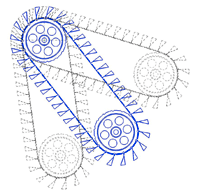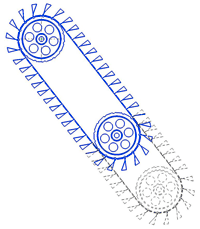Click here to register!
Difference between revisions of "Steffturbine - Hydropower Turbine"
***** (***** | *****) |
***** (***** | *****) |
||
| Line 1: | Line 1: | ||
| − | |||
| − | |||
==== Harnessing water power in small-scale topographic settings<br/> ==== | ==== Harnessing water power in small-scale topographic settings<br/> ==== | ||
In the search for methods of power generation that are as eco-friendly as possible, the harnessing of water power is becoming increasingly important. Of particular interest are solutions in the smallest application area, with low heads and limited throughflow. These micro power plants allow water resources in small-scale topographic settings to be harnessed and converted into electrical energy. | In the search for methods of power generation that are as eco-friendly as possible, the harnessing of water power is becoming increasingly important. Of particular interest are solutions in the smallest application area, with low heads and limited throughflow. These micro power plants allow water resources in small-scale topographic settings to be harnessed and converted into electrical energy. | ||
| − | |||
| − | |||
<br/> | <br/> | ||
| Line 47: | Line 43: | ||
<br/> | <br/> | ||
| − | |||
==== Further Information ==== | ==== Further Information ==== | ||
| Line 62: | Line 57: | ||
[http://www.vms-detmold.de/index.php/wtw-informationen-vorschau-archiv?aus=1&jahrgang=2012&heft=12&s_sw_url=steffturbine [2]] Maerker C., Trachsler M., Widmer F.: Ein Jahr Steffturbine in Rüti/Schweiz – Erfahrungen aus dem laufenden Betrieb einer Pilotanlage in der Schweiz. Wassertriebwerk 12 | 2012, Seiten 232–237.<br/> | [http://www.vms-detmold.de/index.php/wtw-informationen-vorschau-archiv?aus=1&jahrgang=2012&heft=12&s_sw_url=steffturbine [2]] Maerker C., Trachsler M., Widmer F.: Ein Jahr Steffturbine in Rüti/Schweiz – Erfahrungen aus dem laufenden Betrieb einer Pilotanlage in der Schweiz. Wassertriebwerk 12 | 2012, Seiten 232–237.<br/> | ||
| + | [[Category:Hydro]] | ||
| + | [[Category:Italy]] | ||
| + | [[Category:Tanzania]] | ||
[[Category:Micro_Hydro]] | [[Category:Micro_Hydro]] | ||
| − | |||
| − | |||
| − | |||
Revision as of 11:04, 4 April 2013
Harnessing water power in small-scale topographic settings
In the search for methods of power generation that are as eco-friendly as possible, the harnessing of water power is becoming increasingly important. Of particular interest are solutions in the smallest application area, with low heads and limited throughflow. These micro power plants allow water resources in small-scale topographic settings to be harnessed and converted into electrical energy.
Engineering concept
The Steffturbine has been developed in response to this requirement. The small turbine is based on the principle of the oberschlächtigen Wasserrads and essentially exploits the potential energy of water. Its main components are a continuous double chain running around two guide wheels and supporting stainless-steel paddles (Fig. 1). An integrated permanent magnet generator converts mechanical output into AC electrical power. The design of the Steffturbine is modular; its length can be varied and adjusted to suit the local topography. Depending on the terrain, it is possible to operate several Steffturbines side-by-side in order to achieve a higher total output (Fig. 2).
Output and efficiency
A head of 3 to 5 metres will create the ideal operating conditions for the Steffturbine, when the small-scale system will achieve an output of 12 kW. At its current stage of technical development, measurements show that Wirkungsgrad peaks at 92 percent (Fig. 3).
Applications
Die kompakt gebaute Steffturbine ist vielseitig einsetzbar. Für die Energienutzung eignen sich Fliess- und Staugewässer, Kläranlagen, Bewässerungseinrichtungen, Auslaufkanäle bestehender Kraftwerke, das Prozesswasser in Industriebetrieben, Standorte alter Mühlen oder Staustufen, die einer Revitalisierung bedürfen. Der Neigungswinkel der Steffturbine lässt sich dem jeweiligen Gelände anpassen. Im Extremfall ist die Gewinnung von Elektrizität durch den horizontalen Wasserdurchfluss unter Nutzung der kinetischen Energie möglich (Fig. 4 und Fig. 5).
Die von der Steffturbine erzeugte Elektrizität kann in das öffentliche Netz eingespeist, im Rahmen einer Insellösung genutzt oder in Kombination mit anderen Energieerzeugern (Erdwärme, Sonne, Wind) in ein Verbundnetz eingebracht werden. Durch ihre Anpassungsfähigkeit ist der Einbau der Steffturbine ohne Eingriffe in bestehende Ökosysteme möglich.
A Swiss development
The Steffturbine is a development of WRH Walter Reist Holding AG working together with the University of Munich. WRH Walter Reist Holding AG, with headquarters in Hinwil (Switzerland), is an international, family-owned company specialized in the development of innovative conveyor and processing systems with proven and successful applications in the printing, food and pharmaceutical industries, as well as in automobile manufacturing. The conveyor technology also forms the basis for the Steffturbine, which has been marketed by WRH Walter Reist Holding AG since 2012 through its own worldwide sales and distribution organization.
Projects in Italy and Tanzania
Initial projects with the Steffturbine are underway. In Nyangao, in the Lindi region of Tanzania, for example, a small-scale hydroelectric power plant is planned. A Steffturbine will supply electricity to a school and adjacent houses as part of a self-sufficient system, with the dam outlet from a small reservoir being harnessed as a source of hydro power.
The realization of a further Steffturbine project is scheduled for the region around Parma (Italy). Two irrigation systems bringing water to arable land will serve as the energy source, and the power thus generated will be fed into the grid.
Further Information
References
[1] Malcherek A., Kulisch H., Maerker C.: Die Steffturbine – eine auf einem Umlaufband beruhende Kleinwasserkraftanlage. WasserWirtschaft 10 | 2011, Seiten 30–33.
[2] Maerker C., Trachsler M., Widmer F.: Ein Jahr Steffturbine in Rüti/Schweiz – Erfahrungen aus dem laufenden Betrieb einer Pilotanlage in der Schweiz. Wassertriebwerk 12 | 2012, Seiten 232–237.
























